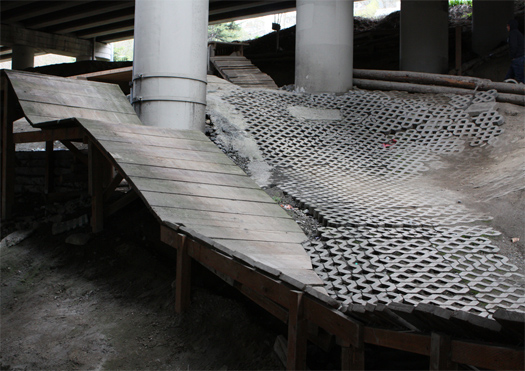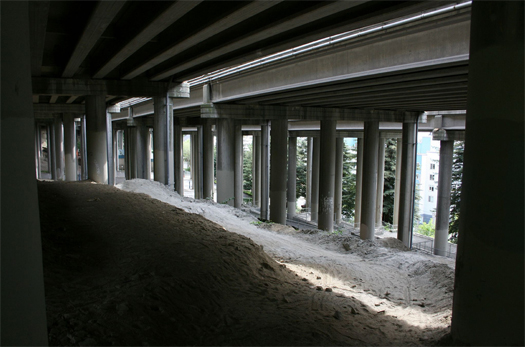
[Colonnade Park, photographed by Brett Milligan.]
Free Association Design reports from Seattle’s Colonnade Park, an “urban mountain bike skills park” constructed by volunteers from the Evergreen Mountain Bike Alliance:
It hard not to be enamored by the successful and improvised gestalt of the whole thing, in both program and materials. Much of what it is made of was donated or recycled from demolition projects around the city. And typical off-the-shelf items, like permeable waffle pavers (above), have been retooled as robust and removable cellular confinement systems…
One comes away with the impression that the park will keep remaking itself incrementally, over and over again. Pieces and segments will be modified as they wear out, with new experiments being plugged in as desired. It seems that the builders and volunteers that have constructed it might actually be a little forlorn if the park were ever fully finished.
There’s a really instructive contrast to be drawn between this and, say, the High Line (though I could use other examples). Both enter a messy, dis-used slice of urban space which draws its appeal specifically from that mess and dis-use, but where the High Line parodies and imitates that appeal, the incremental additions Milligan describes amplify its appeal. The angled planes of waffle pavers, crudely assembled wooden ramps, and bermed piles of earth are, in their raw instrumentality, at ease between the orderly forest of concrete columns in a way that ‘sophisticated’ details likely could never be, and so Colonnade Park seems an exceptionally comfortable appropriation of an infrastructural left-over as a public space. These are the details of an infrastructural vernacular.
It’s probably equally interesting to me that these details — which are beautifully crafted, though in a far different sense than traditional detailing — emerge in the absence of the kinds of drawings that we tend to associate with artful landscape practice [1]. Instead, their sophistication results from the accumulation of hours of volunteer labor — labor which, being the labor of the mountain bikers who use the park, was and is intimately acquainted with mountain biking, and so has been constructing the park with a refined understanding of the spatial practices that will be situated in it.

[For comparison: an undeveloped portion of Colonnade Park; photographed by flickr user mmallory.]
And this suggests a third point of interest: Colonnade Park, as it is both a site for recreation and site which is produced through labor, is an iteration of what FASLANYC has described as “leisure-work” [2].
“…leisure-work we define as a form of recreation — meant to recreate the body and soul — as opposed to production. While leisure-work may have some productive value (just as production-work may have some recreative value) and they may take similar forms, their motivations are ontologically different.”
What fascinates me about this is that where FASLANYC’s prior examples of “leisure-work” — like the Kongjian Yu project at the Architectural University in Shenyang — have tended to be places where a framework is established by a landscape architect and then people come and engage in leisure-work on that site, producing some good (food, for instance) which can be used elsewhere, Colonnade Park itself is the immediate subject of the leisure-work performed. Colonnade Park is not a container for leisure-work, but is the shifting and malleable continuous product of that leisure-work. This in turn suggests a direct applicability to ecological productivity: while the performance metrics which Colonnade Park is shaped towards are the requirements of mountain biking, it is not at all difficult to imagine a parallel Ecological Leisure-Work Park, where recreational work is directed towards the end of ecological productivity, producing (almost as a by-product) an alternative aesthetic formed by the confluence of labor and ecologies, acknowledging and subsuming lo-fi practices, the D.I.Y. aesthetic, wild urban plants, freakologies, cryptoforestry, ecological performance metrics, labor-intensive restoration practices, gardening, guerilla gardening, seed bombing, anthropogenic and post-natural landscapes, resilience science, urbanibalism, and so on.
Click through to F.A.D. for more photographs; I also recommend this older FASLANYC post on “entertainment versus work” and “the changing nature of recreation in New York”.

